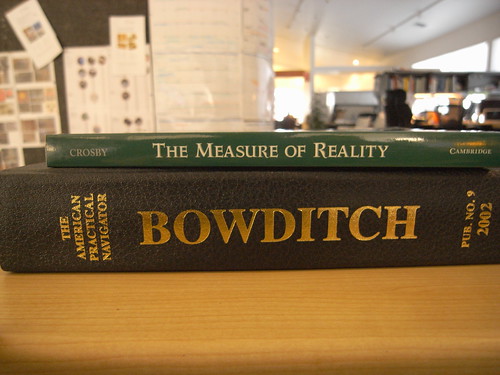Anticipating the less-than-lovely side of ubiquitous computing scenarios, this photo is the end point of a circuitous GPS navigation FAIL on the way to relatives for Thanksgiving dinner last week. Looks like we’re driving into the river there. After what we went through, it wouldn’t surprise me if the GPS lady sent us right on into the ol’ Housatonic.
We made it unscathed but a bit dizzy from the miscues and miscommunications that were the result of an entangled navigation assemblage of people, roads, cellular telephony and satellite location practices. Along the route from northern New Jersey to somewhere in the woods of Connecticut we ended up departing from what seemed like the correct route along a major highway, but were told to exit by the lady in the GPS box, which I did with a little bit of raised eyebrows from the cohabitants of the car, including myself. I was skeptical initially, thinking that the GPS had been misprogrammed to another set of relatives whose home was somewhere around there. So, there was that, which implied a bit of skepticism tossed at the vehicle’s copilot, which caused some tension, on top of everything else. The GPS lady sent us down a couple of surface streets that constituted a short diversion around and then immediately back onto the same highway, in the same direction, toward the same goal.
This same “bug” (or whatever..) happened again further along, with the GPS lady taking us off route, onto some surface streets to make a long U-turn and then (conveniently and fortuitously) into the parking lot of a Dunkin’ Donuts, which allowed for a bathroom break. GPS lady then told us to get back onto the same highway.
This is either real HAL 9000 style Ubicomp, a test by “the man” to see how much people will blindly listen to their GPS ladies and do ridiculous things, or a case-in-point as to how sucky these things are to begin with. By this point, we were fairly skeptical about the ability of the GPS to navigate, and the conversations turned to things like — maybe the maps need to be updated and questions about Amazon’s return policy. Things like that. Meanwhile, alternative mechanisms were deployed to further entangle the navigation process — iPhones were fingered, alternative routes suggested, questions were raised about the fitness of one biway over another roughly parallel highway, calls were made to discuss alternatives and readjust anticipated arrival times, conversations on phone calls were taken as Gospel directions when they were really questions to the person on the other end (who couldn’t be heard except by the caller — as in “Take a left at the bridge.”, which really was “Take a left at the bridge?” and so a left was taken at the bridge, etc.) Confusion ensued (big time) as navigation became a group activity, which seems entirely a bad idea under even the most pleasant of circumstances. In summary — the same old sort of people-practices that have always gone into navigation and mobility practices, despite the GPS lady and her fancy tricks.
Why do I blog this?Another in a series of observations about the failure of technical instruments like GPS’s were meant to ameliorate, with a bit of cynacism towards the Ubicomp pink pony dream. Despite the dream and vision of fancy-futures, the entanglement of humans and non-humans into a knotted cooperative does not look like the advertising literature and product descriptions.
Continue reading GPS 9000

